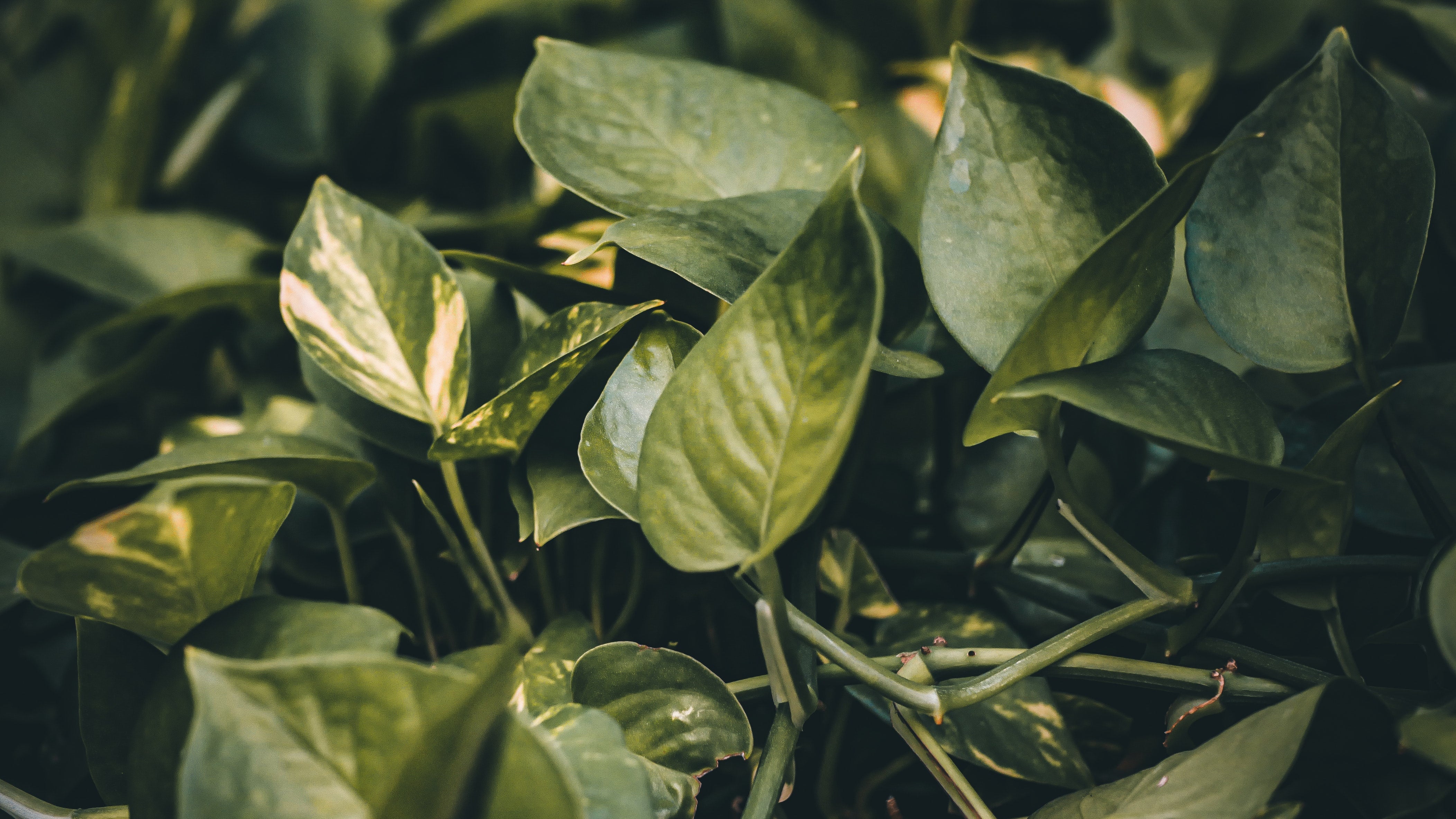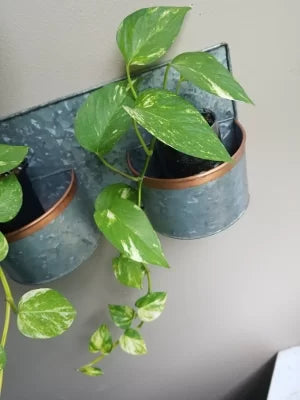
Pothos Complete Care Guide
(AKA Devil’s Ivy, AKA Epipremnum Aureum)
That’s right! Golden Pothos! Devil’s Ivy, Hunter’s Robe, Silver Vine, Epipremnum aureum (not to be confused with Philodendron)! Also, one of the countless plants carrying the moniker “Money Plant” (every plant’s money plant to the guy you get it from)! This beautiful, quick-growing vine is simply one of the best and most popular houseplants around. In my personal experience it’s the most difficult to kill plant I’ve ever had the pleasure of raising. Before I get into how creepily obsessed I am with perfect, pretty Pothos, here are all the deets you need to know to be successful keeping this green-gold variegated buddy on your windowsill.
Light
Bright, but indirect or filtered light is ideal. Variegation is key with Pothos – mostly green leaves are an indication that your plant isn’t getting enough light. Conversely, if your plant is looking paler and yellower than normal, it could be getting too much light. While Pothos is known for being tolerant to a wide variety of light conditions (including low, and, to a much lesser degree direct), a happy and healthy plant will be bright green, variegated, but not yellow or white. Only the green parts of the plant photosynthesize, so if you put a well variegated plant in low light conditions, it will begin to fill itself in to compensate. The plant speaks for itself!

Golden Pothos -- Happy, healthy!
Water
Maintaining your plant’s watering schedule is what makes keeping Pothos alive so easy. When it’s thirsty, the leaves start to droop, lose their gloss, and veins might begin to show. Give your buddy a drink! Keep your soil moist, never soaked, and allow it to dry somewhat between watering. Usually once a week will suffice. Make sure you’ve chosen a pot with drainage holes for proper aeration, as Pothos can be prone to rot if kept too wet. Yellow leaves can be a sign of root rot, however Pothos leaves also brown/yellow and drop one at a time from closest to the dirt if the plant is severely dehydrated, leaving you with a lanky, bare looking plant that’s a good candidate for cutting up (see propagation below).
Soil
While Devil’s Ivy adapts well to water culture, it will be much happier in soil where it can absorb nutrients more readily. Water is a better means for rooting cuttings rather than growing full size plants. If you have a plant that’s been started in water, it won’t adapt well to soil, and vice versa. Any standard potting mix should work well for your plant. Keep in mind that Pothos plants have small, shallow root systems, so large pots are unnecessary and could retain too much moisture. Drainage is very important for any plant’s health.
Fertilizer
Pothos is easy-going as far as houseplants are concerned. They will grow fine without any fertilizer, but if you want your plant to grow quickly, fertilize every 1-3 months with a balanced 20-20-20 fertilizer.
Propagation
Propagation is incredibly easy with Pothos plants. If you prefer to watch things as they grow, pop off a cutting and stick it in a glass of water (tip cuttings work well with this method). Pothos roots very quickly, so save your rooting hormone for more finicky plants! For a more straightforward path to a complete plant, I prefer to put five or so cuttings together in a 3 to 4 inch pot filled with standard potting mix. Begin by cutting the stem of a vine into sections, each containing one leaf, and part of the stem. The little bumps along the stem that the plant uses to hinge onto things/facilitate its climbing habit are actually the nodes where new roots will form – so make sure each cutting you take has a few bumps with it. Keep in mind that wherever you cut the stem will terminate axial growth. If you want a bushier plant, take cuttings frequently, but make sure you leave enough leaves for your plant to photosynthesize. If you’re looking for a long trailing vine to wrap around your room, I recommend taking no cuttings at all. Pot your cuttings an inch deep or less, being careful not to put too much of the petiole below the soil line to avoid rot. Keep the soil consistently moist until new growth begins to show, which is a sure sign roots have formed.
Everything Else
Epipremnum aureum was first classified in 1880 as Pothos aureus, which is why most people still call it Pothos today. It’s a tropical plant native to French Polynesia – and believe it or not, it used to flower! The only species grown indoors, however, doesn’t, due to a genetic mutation. It’s an evergreen vine with alternating heart-shaped leaves, capable of growing up to 60 feet in the wild – but usually no more than six to ten at home. It uses aerial roots to climb along trees, but as it only roots when in contact with the ground, it’s decidedly not an epiphyte. Some popular cultivars include Golden Pothos, Marble Queen, Silver, Cebu Blue, Pearls and Jade, Jessenia, and Neon Pothos – all with varying colored leaves from almost yellow to dark forest green, and variegation from white to gray to any green or yellow in-between. Some enthusiasts root Pothos in their aquariums, a kind of symbiotic water culture, since Pothos happily absorbs unwanted nitrates from fishy water. Keeping this plant at home can be beneficial to us as well – it cleans pollutants from the air (calling all my fellow asthmatics)! Unfortunately, Pothos is toxic when ingested, so keep it up high and away from any curious furry friends.
The Takeaway
- Place in bright, but not direct sunlight
- Water until moist but not wet – allow topsoil to dry between watering
- Choose a pot on the smaller side, use standard potting mix
- Fertilize every 1-3 months for more vigorous foliage growth
- Pothos is the undisputed ~International Heavyweight Champion~ of Easy Propagation

Leave a comment: